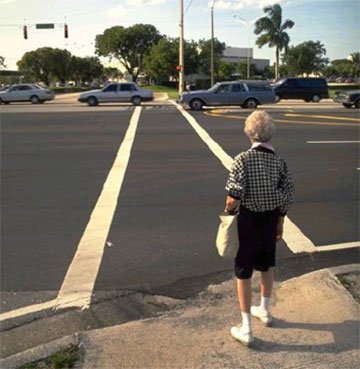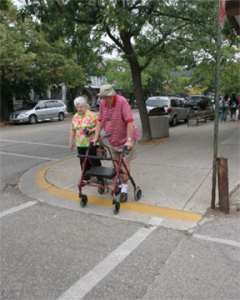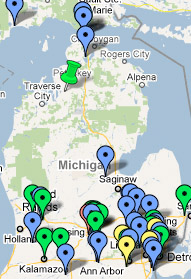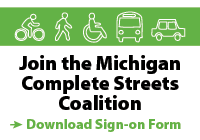
Wide streets, even with crosswalks and signals, are intimidating to older persons and can make it hard for seniors to even see the walk signal. Refuge medians that allow people to cross one direction of traffic at a time make it much easier for slower pedestrians to get around.

Wide streets, even with crosswalks and signals, are intimidating to older persons and can make it hard for seniors to even see the walk signal. Refuge medians that allow people to cross one direction of traffic at a time make it much easier for slower pedestrians to get around.
Report shows need to do more for pedestrians
Many of Michigan’s roads are getting in our way. They lack sidewalks, and too many crosswalks require a daunting six-lane sprint. Bus stops are nothing more than poles in the grass.
There is an approach to road design that can help get us where we want to go that stresses safety for all users and it encourages not only efficiency, but also a pleasant user friendly environment.
AARP’s new report, “Planning Complete Streets for an Aging America,” makes the case that it is especially important to pay attention to improving roads now, as the boomers age.
Despite the oncoming stream of older boomers, according to a survey for the new report, more than two-thirds of transportation planners and engineers have not begun to consider the needs of older people in street planning. In Michigan, we have a chance to eliminate that blind spot by urging policy-makers and transportation professionals to focus on older users. It would ensure that road projects funded by federal dollars are safe and convenient for all users.

Complete streets make it much easier for seniors to stay active, particularly when they require assistance in the form of a cane, walker, or wheelchair.
Although over 90 percent of the trips we Americans take are in our cars and trucks, more and more of us are trying to drive less. Unfortunately, as we get out of our cars, according to another survey for AARP’s report, most people over age 50 are finding that our neighborhoods don’t have adequate sidewalks (40 percent) and that nearly half of us (47 percent) feel streets near our homes are unsafe to cross on foot.
Transit accounted for more than 10.7 billion trips in 2008, but four out of five of us age 50-plus report that transit services are often not available. Even when it is, older people considering using public transportation face bus stops without safe crosswalks, shelters, or benches.
Yet, 54 percent of those living in inhospitable neighborhoods said they would walk and ride more often if conditions improved.
“Complete Street” planning principles coupled with sound land use policy can help to create the walkable, mixed-use, transit friendly communities so beneficial to us all.
AARP’s “Planning Complete Streets” report recommends three perspectives for transportation planners and engineers:
1. Make the physical layout of roads, crosswalks and sidewalks easier to navigate.
2. Reduce vehicle travel speeds at intersections where drivers and pedestrians need more time to make decisions and execute changes.
3. Make it easier for drivers and pedestrians to notice, read, understand and respond to visual cues and information.
With improved street networks, we all can live more safely and comfortably in our neighborhoods and older adults can age successfully where they want to be - in their home or community - where they overwhelmingly want to stay. The livability of our communities depends on having safe travel choices, so let’s advocate for improved street design and safer travel choices.
Karen Kafantaris is associate state director for community service for AARP Michigan.
This article originally appeared in the Lansing State Journal, June 3, 2009
















1 comment
Comments feed for this article
June 24, 2009 at 2:37 pm
lindenmayer
More information on how Complete Streets can improve mobility for older Americans can be found at: http://www.completestreets.org/complete-streets-fundamentals/factsheets/older-adults/